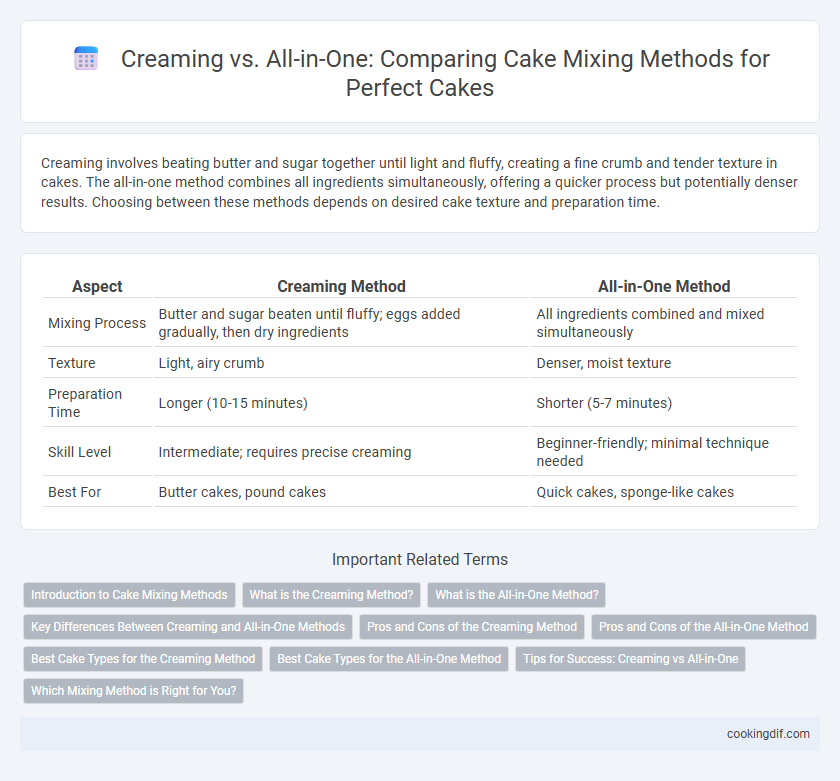Creaming involves beating butter and sugar together until light and fluffy, creating a fine crumb and tender texture in cakes. The all-in-one method combines all ingredients simultaneously, offering a quicker process but potentially denser results. Choosing between these methods depends on desired cake texture and preparation time.
Table of Comparison
| Aspect | Creaming Method | All-in-One Method |
|---|---|---|
| Mixing Process | Butter and sugar beaten until fluffy; eggs added gradually, then dry ingredients | All ingredients combined and mixed simultaneously |
| Texture | Light, airy crumb | Denser, moist texture |
| Preparation Time | Longer (10-15 minutes) | Shorter (5-7 minutes) |
| Skill Level | Intermediate; requires precise creaming | Beginner-friendly; minimal technique needed |
| Best For | Butter cakes, pound cakes | Quick cakes, sponge-like cakes |
Introduction to Cake Mixing Methods
Creaming and all-in-one are fundamental cake mixing methods that influence texture and flavor. Creaming involves beating butter and sugar until light and fluffy, incorporating air for a tender crumb. The all-in-one method combines all ingredients simultaneously, streamlining the process while producing a denser, moister cake.
What is the Creaming Method?
The Creaming Method involves beating butter and sugar together until light and fluffy, creating a stable fat mixture that traps air and helps produce a tender, airy cake texture. This method ensures even distribution of ingredients, resulting in a consistent crumb structure and enhanced volume. Commonly used in butter cakes, the creaming technique requires gradual incorporation of eggs and dry ingredients to maintain aeration and achieve optimal rise.
What is the All-in-One Method?
The All-in-One method involves combining all the ingredients--flour, sugar, eggs, butter, and leavening agents--at once before mixing into a batter. This technique streamlines preparation by reducing mixing time and minimizing the risk of overworking the batter, resulting in a tender and moist cake. It is especially effective for simple, everyday cakes and is favored for its efficiency in home baking.
Key Differences Between Creaming and All-in-One Methods
The creaming method involves beating butter and sugar together until light and fluffy, creating a fine crumb texture by incorporating air, while the all-in-one method mixes all ingredients simultaneously for a quicker, less aerated batter. Creaming produces a more tender and structured cake due to the gradual mixing and aeration, whereas the all-in-one method yields denser, moister cakes suitable for faster preparation. Key differences lie in texture, mixing time, and aeration intensity, with creaming requiring more effort but delivering a lighter crumb.
Pros and Cons of the Creaming Method
The creaming method involves beating butter and sugar together until light and fluffy, creating a tender and airy cake texture due to the incorporation of air. This technique provides better control over the mixing process, resulting in a more consistent crumb and enhanced flavor development. A drawback is that it can be time-consuming and requires softened butter, which may slow preparation compared to faster methods like the all-in-one.
Pros and Cons of the All-in-One Method
The All-in-One method simplifies cake preparation by combining all ingredients at once, reducing mixing time and minimizing equipment use. This technique often produces a tender crumb due to less air incorporation but may result in a denser texture compared to the Creaming method. While ideal for quick recipes, the All-in-One approach can compromise volume and lightness, making it less suitable for cakes requiring a delicate or fluffy structure.
Best Cake Types for the Creaming Method
The creaming method is ideal for butter-based cakes such as classic pound cake, butter cake, and yellow cake due to its ability to incorporate air into the batter, resulting in a light and fluffy texture. This technique excels in recipes requiring a tender crumb and substantial rise, making it less suitable for sponge cakes which often use the all-in-one method. Cakes like red velvet and carrot cake also benefit from creaming because it enhances moisture and structural integrity.
Best Cake Types for the All-in-One Method
The All-in-One method is ideal for producing moist and tender cakes such as sponge cakes, pound cakes, and butter cakes due to its simplicity and reduced mixing time. This technique combines all ingredients simultaneously, promoting even hydration and a consistent batter texture that enhances crumb structure. Cakes made with the All-in-One approach typically exhibit fine crumbs and moistness, making it perfect for everyday cakes and quick-bake recipes.
Tips for Success: Creaming vs All-in-One
For successful creaming method, ensure butter is softened to room temperature and beat it with sugar until light and fluffy to incorporate air for a tender crumb. In the All-in-One method, carefully mix dry and wet ingredients together in one bowl, avoiding over-mixing to prevent dense texture. Using precise ingredient measurements and maintaining consistent mixing speed are crucial for both methods to achieve optimal cake rise and crumb structure.
Which Mixing Method is Right for You?
The creaming method, ideal for light and airy cakes, involves beating butter and sugar until fluffy, creating a tender crumb and rich flavor. The all-in-one method combines all ingredients simultaneously, offering convenience and speed suitable for beginners or quick recipes. Choose creaming for texture and depth, or all-in-one for simplicity and efficiency in your cake baking.
Creaming vs All-in-one for cake mixing methods Infographic

 cookingdif.com
cookingdif.com